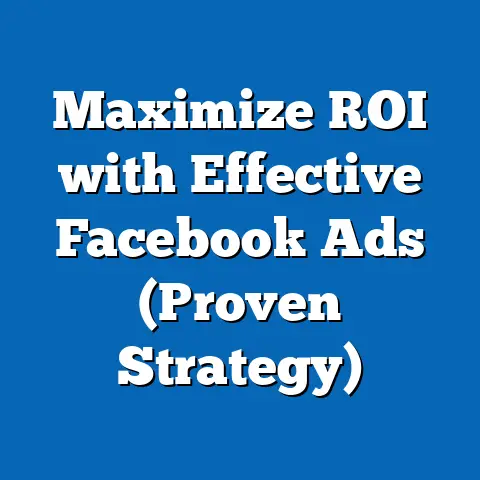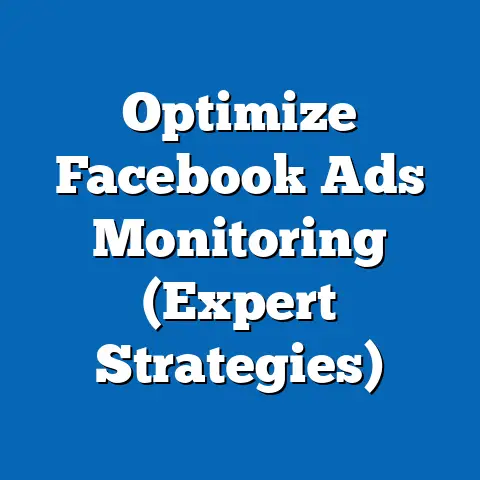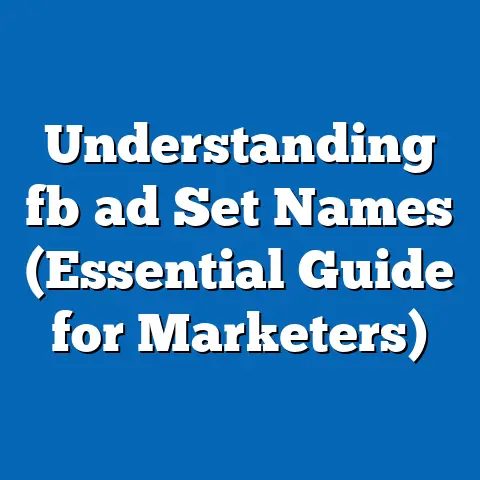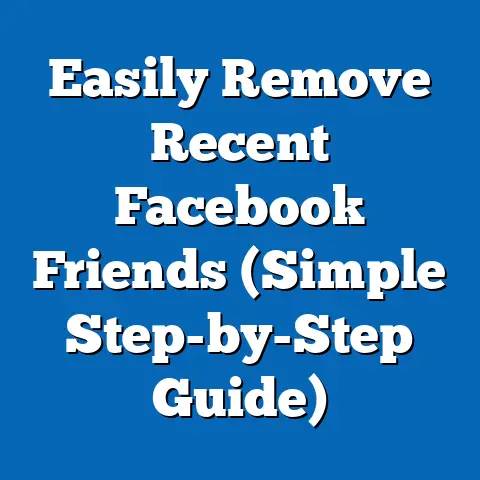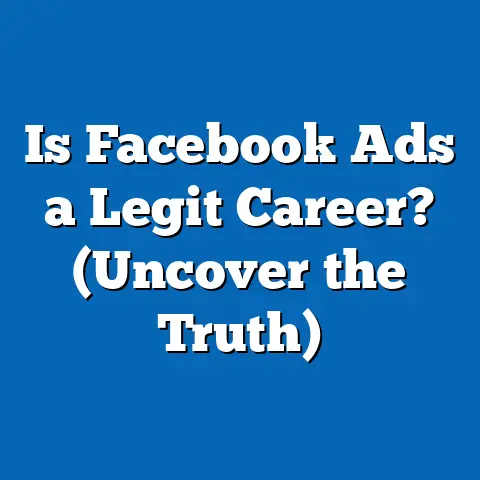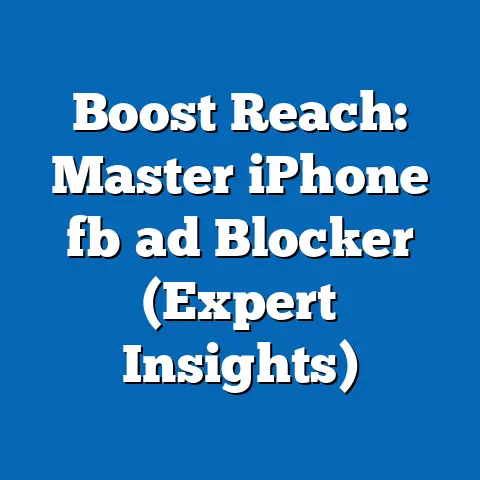Boost Engagement with Facebook Instream Ads (Pro Strategies)
Imagine a world where billions of users scroll through their social media feeds daily, pausing only for a fleeting moment to engage with content that captivates their attention. In this fast-paced digital ecosystem, Facebook stands as a colossus, boasting over 2.9 billion monthly active users as of 2023, according to Statista. Within this vast network, a powerful advertising tool has emerged—Facebook Instream Ads—designed to capture attention mid-stream during video content, blending seamlessly into the user experience.
Instream Ads represent a pivotal shift in how brands connect with audiences, leveraging the growing appetite for video content, which Cisco predicts will account for 82% of global internet traffic by 2024. These ads, embedded within videos on Facebook and its partner platforms, offer a unique opportunity to engage users at peak moments of attention. However, their success hinges on a deep understanding of audience behavior, creative execution, and strategic optimization.
Defining Characteristics of Facebook Instream Ads
Facebook Instream Ads are short video advertisements that play automatically during video content on the platform, including in Facebook Watch, News Feed, and Audience Network placements. Unlike traditional banner ads or static posts, these ads are integrated into the viewing experience, appearing before, during, or after videos. They are typically non-skippable for the first few seconds, ensuring initial exposure, though users can often skip after 5-10 seconds depending on the format.
Key characteristics include their immersive nature, precise targeting capabilities, and performance-driven metrics. Instream Ads are designed to blend with organic content, minimizing disruption while maximizing relevance through Facebook’s robust data on user preferences and behaviors. They support various objectives, from brand awareness to conversions, and offer detailed analytics on view-through rates, engagement, and audience retention.
Importantly, these ads cater to a mobile-first audience, as over 90% of Facebook users access the platform via mobile devices, per internal company reports. This mobile-centric focus demands concise messaging and visually striking content to capture attention in mere seconds. Understanding these defining traits is critical for crafting strategies that resonate with viewers and drive meaningful engagement.
Historical Context: The Evolution of Digital and Video Advertising
The rise of Facebook Instream Ads cannot be divorced from the broader evolution of digital advertising, which began in the mid-1990s with the first clickable banner ad on HotWired.com. By the early 2000s, platforms like Google introduced search-based ads, revolutionizing how brands reached consumers through intent-driven targeting. Social media platforms, including Facebook, entered the scene shortly after, launching advertising solutions that capitalized on personal data and social interactions.
Video advertising gained prominence with YouTube’s launch in 2005 and the subsequent introduction of pre-roll ads. As internet speeds improved and smartphones proliferated, video consumption skyrocketed, paving the way for platforms like Facebook to prioritize video content. In 2015, Facebook introduced autoplay videos in the News Feed, a precursor to Instream Ads, which officially rolled out in 2017 as part of the platform’s push into premium video monetization through Facebook Watch.
This historical trajectory reflects broader societal shifts toward on-demand content and shorter attention spans, influenced by the rise of streaming services and social media. The introduction of Instream Ads aligns with these trends, offering advertisers a way to intercept users during high-engagement moments. Understanding this context helps marketers appreciate the urgency of adapting to a video-first world where competition for attention is fiercer than ever.
Societal Implications: Changing Consumer Behavior and Ethical Considerations
The proliferation of Facebook Instream Ads mirrors a societal pivot toward video as a primary mode of communication and entertainment. With younger generations, such as Gen Z and Millennials, spending an average of 2-3 hours daily on social media (per Pew Research Center, 2022), video content has become a cultural cornerstone. Instream Ads tap into this trend, embedding brand messages into moments of leisure and connection.
However, their pervasive nature raises ethical questions about privacy and user experience. Facebook’s targeting capabilities, while powerful, rely on vast amounts of personal data, sparking debates over surveillance and consent, especially post-Cambridge Analytica in 2018. Additionally, the non-skippable element of Instream Ads can frustrate users if not executed thoughtfully, potentially leading to ad fatigue or negative brand associations.
On a positive note, these ads democratize advertising by allowing small businesses to compete with larger corporations through accessible tools and granular targeting. They also drive economic activity by supporting content creators who monetize videos via ad revenue sharing. Balancing these benefits with ethical considerations is crucial for advertisers aiming to build trust while maximizing engagement.
The Importance of Engagement in the Digital Age
Engagement—measured through likes, shares, comments, and click-through rates—is the lifeblood of digital advertising. Unlike traditional media, where exposure was the primary metric, social media platforms prioritize interactions as indicators of relevance and impact. For Instream Ads, engagement is particularly critical given their interruptive nature; a poorly received ad risks alienating viewers, while a well-crafted one can spark virality.
Data from Social Media Today (2023) indicates that video ads with high engagement rates can achieve up to 30% lower cost-per-click compared to static ads. This underscores the financial incentive to prioritize user interaction. Engagement also fosters brand loyalty, as users who interact with content are more likely to remember and trust the brand, according to a 2022 study by Nielsen.
In the context of generational dynamics, engagement strategies must account for diverse preferences. For instance, Gen Z values authenticity and humor, often responding to ads that feel less polished but more relatable, while Baby Boomers may prioritize clear value propositions. Tailoring Instream Ads to these nuances is essential for cutting through the noise of a crowded digital space.
Pro Strategies for Boosting Engagement with Facebook Instream Ads
To unlock the full potential of Facebook Instream Ads, marketers must adopt a strategic, multi-faceted approach. The following sections outline professional strategies grounded in data, creativity, and platform-specific best practices. These insights aim to help advertisers not only capture attention but also inspire meaningful interactions across diverse audiences.
1. Craft Compelling Creatives with a Strong Hook
The first 3-5 seconds of an Instream Ad are make-or-break. With users conditioned to scroll past irrelevant content, a strong hook—whether a striking visual, provocative question, or emotional trigger—is non-negotiable. Research by Facebook IQ (2021) shows that ads with a clear focal point in the opening frame achieve 27% higher view-through rates.
Consider incorporating bold text overlays, dynamic motion, or recognizable branding elements early on. For example, a fitness brand might open with a high-energy workout clip and a caption like “Transform in 30 Days!” to grab attention. Testing multiple creative variations through A/B testing ensures you identify what resonates most with your audience.
Additionally, keep videos concise—ideally 15-30 seconds—to align with shrinking attention spans. Focus on a single, clear message, avoiding clutter or overcomplicated narratives. Remember that mobile users often watch without sound, so captions and visual storytelling are critical for accessibility and impact.
2. Leverage Advanced Targeting and Lookalike Audiences
Facebook’s targeting tools are among the most sophisticated in the industry, allowing advertisers to pinpoint users based on demographics, interests, behaviors, and past interactions. For Instream Ads, layering these options can significantly boost relevance and engagement. Start by defining your core audience—consider age, location, and interests aligned with your brand.
Lookalike Audiences, which identify users similar to your existing customers, are particularly effective for expanding reach without sacrificing relevance. A 2022 case study by Hootsuite found that campaigns using Lookalike Audiences saw a 20% increase in engagement compared to broader targeting. Combine this with retargeting to re-engage users who’ve interacted with your content, ensuring your ads stay top-of-mind.
Be mindful of generational nuances in targeting. Younger audiences may respond to trendy hashtags or influencer partnerships, while older users might appreciate ads tied to life milestones like retirement or family events. Customizing messaging to these segments prevents a one-size-fits-all approach that often falls flat.
3. Optimize for Mobile-First Viewing
Given that the majority of Facebook users access the platform via mobile devices, Instream Ads must be optimized for smaller screens and vertical formats. Use a 9:16 aspect ratio for full-screen immersion, ensuring key elements aren’t cut off in portrait mode. High-resolution visuals and legible text (minimum 14-point font for overlays) are essential for clarity.
Audio optimization is equally important—while many users watch silently, those with sound enabled expect crisp, clear audio. Include subtitles or captions to cater to both scenarios, as studies show captioned ads increase view time by 12% (Facebook Business, 2020). Test playback on various devices to ensure consistent quality.
Mobile optimization also extends to loading times. Compress video files without sacrificing quality to prevent buffering, which can lead to drop-offs. A seamless viewing experience keeps users engaged, particularly younger generations accustomed to instant gratification in digital interactions.
4. Incorporate Interactive Elements and Calls-to-Action
Passive viewing doesn’t drive engagement—interaction does. Incorporate elements like polls, quizzes, or clickable overlays within your Instream Ads to encourage active participation. For instance, a beauty brand might ask viewers to “Vote for Your Favorite Look!” with options linked to product pages, blending engagement with conversion potential.
Strong calls-to-action (CTAs) are equally vital. Phrases like “Learn More,” “Shop Now,” or “Join Us Today” should be visually prominent and contextually relevant. According to WordStream (2023), ads with clear CTAs achieve 38% higher click-through rates compared to those without.
Tailor CTAs to generational preferences—Gen Z might respond to gamified prompts like “Unlock Your Discount!” while Millennials may prefer value-driven CTAs like “Save 20% Now.” Experiment with placement (e.g., mid-roll vs. end-roll) to determine what maximizes interaction without disrupting the viewing experience.
5. Analyze Performance Metrics and Iterate Continuously
Data is the backbone of successful Instream Ad campaigns. Facebook’s Ads Manager provides granular insights into metrics like completion rates, engagement rates, and cost-per-view, enabling marketers to assess what works and what doesn’t. Focus on benchmarks like 50% video completion as a sign of sustained interest, per industry standards.
Use these insights to iterate on creative and targeting. If an ad underperforms with a specific demographic, adjust messaging or visuals to better align with their values. For example, if Gen X viewers drop off early, consider a nostalgic angle referencing cultural touchstones from the 1980s or 1990s.
Continuous testing is key—allocate a portion of your budget to experimental campaigns exploring new formats or audiences. A 2021 report by eMarketer found that brands that regularly refresh ad content see a 15% uplift in engagement over static campaigns. Staying agile ensures your strategy evolves with user behavior and platform updates.
6. Align with Cultural Trends and Generational Values
Relevance drives resonance. Tap into cultural trends, seasonal events, or viral memes to make your Instream Ads feel current and relatable. For instance, aligning with major holidays or social movements (e.g., sustainability for Earth Day) can amplify emotional connections, particularly with socially conscious generations like Millennials and Gen Z.
However, authenticity is paramount—forced or tone-deaf trendjacking can backfire. A 2022 survey by Sprout Social revealed that 70% of consumers value brands that genuinely reflect their values over those chasing fleeting fads. Research your audience’s priorities through social listening tools to ensure alignment.
Generational values also play a role. Baby Boomers may appreciate ads emphasizing trust and reliability, while Gen Z often gravitates toward diversity and inclusion. Crafting content that mirrors these priorities builds deeper connections and fosters long-term engagement.
7. Collaborate with Influencers and User-Generated Content
Influencers wield significant power in shaping consumer behavior, especially among younger demographics. Partnering with micro- or macro-influencers for Instream Ads can lend credibility and expand reach. A 2023 study by Influencer Marketing Hub found that influencer-led campaigns on social platforms achieve 11 times higher ROI than traditional ads.
Incorporate user-generated content (UGC) to add authenticity. Encourage fans to submit videos showcasing your product, then feature these in your ads with permission. UGC not only reduces production costs but also builds community, as users feel valued and seen.
Balance influencer and UGC strategies with generational appeal. Younger audiences trust peer recommendations, making micro-influencers effective, while older users may respond better to expert endorsements. Tailoring collaborations to these dynamics ensures broader impact.
Challenges and Nuances in Executing Instream Ad Campaigns
While the potential of Facebook Instream Ads is immense, challenges abound. Ad fatigue, where users grow desensitized to frequent or repetitive ads, remains a significant hurdle. A 2022 study by Kantar found that 60% of social media users feel overwhelmed by ad volume, underscoring the need for fresh, varied content.
Platform algorithm changes also pose risks. Facebook frequently updates its ad delivery and content prioritization, impacting visibility. Staying informed through official updates and industry news is essential to adapt swiftly.
Diversity within generational cohorts adds complexity. Not all Millennials share the same tech-savviness, nor do all Baby Boomers resist digital trends. Segmenting audiences beyond age—considering factors like income, location, and lifestyle—prevents oversimplification and enhances targeting precision.
Finally, ethical considerations around data privacy cannot be ignored. With increasing scrutiny from regulators (e.g., GDPR in Europe), transparency in data usage builds trust. Clearly communicating value exchanges (e.g., personalized ads for free content) mitigates backlash and aligns with evolving societal expectations.
Implications for Society, Culture, and Business
The widespread adoption of Facebook Instream Ads reflects and shapes broader societal trends. Culturally, they contribute to the dominance of video as a storytelling medium, influencing how narratives are crafted and consumed across generations. They also amplify visual literacy, as users become adept at interpreting quick, impactful messages.
In the workplace, Instream Ads drive demand for skills in video production, data analytics, and digital strategy. Businesses must adapt by upskilling employees or partnering with specialized agencies to remain competitive. Economically, the ad format supports a creator economy, empowering individuals to monetize content while providing brands affordable advertising avenues.
However, the societal impact isn’t universally positive. The risk of information overload and privacy erosion persists, necessitating a balance between innovation and responsibility. Brands that prioritize user-centric design and ethical practices will likely lead in building sustainable engagement.
Forward-Looking Insights: The Future of Instream Ads
Looking ahead, the trajectory of Facebook Instream Ads will likely be shaped by advancements in AI and augmented reality (AR). AI-driven personalization could refine targeting to unprecedented levels, predicting user preferences in real-time. AR integrations might enable interactive ad experiences, such as virtual try-ons or immersive storytelling, further blurring lines between content and commerce.
Generational shifts will also influence strategy. As Gen Alpha (born after 2010) enters the digital sphere, their native fluency in interactive tech will demand even more innovative formats. Meanwhile, aging populations will require accessible, inclusive designs to remain engaged.
Yet uncertainties loom—regulatory changes, platform pivots, and evolving consumer attitudes toward ads could reshape the landscape. Marketers must remain agile, prioritizing experimentation and user feedback to navigate these unknowns. The future of Instream Ads lies in their ability to evolve as a tool for connection, not intrusion, in an ever-changing digital world.
Conclusion
Facebook Instream Ads represent a powerful intersection of technology, creativity, and audience insight, offering brands a unique canvas to boost engagement in a video-driven era. By understanding their defining characteristics, historical roots, and societal implications, marketers can craft strategies that resonate across generations and cultural contexts. From compelling creatives to data-driven optimization, the pro strategies outlined here provide a roadmap for success.
Yet, the path forward requires nuance—balancing innovation with ethics, relevance with authenticity, and reach with respect for user experience. As digital landscapes evolve, so too must our approaches to engagement, ensuring that Instream Ads remain a bridge to meaningful connections rather than a barrier. In this dynamic space, the brands that listen, adapt, and innovate will ultimately capture not just attention, but lasting loyalty.

